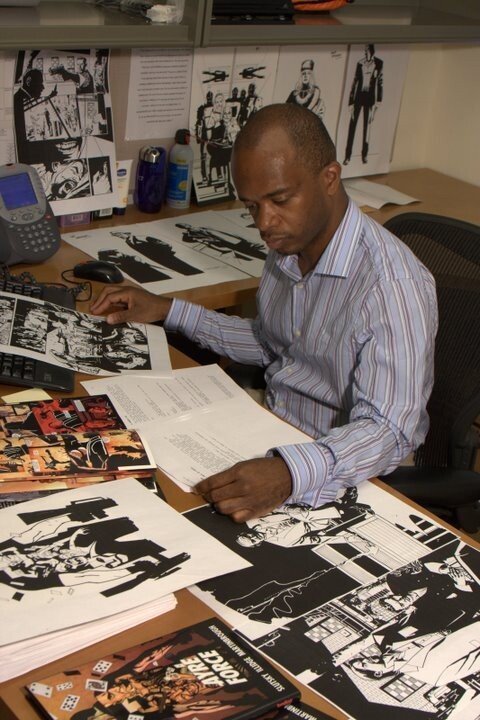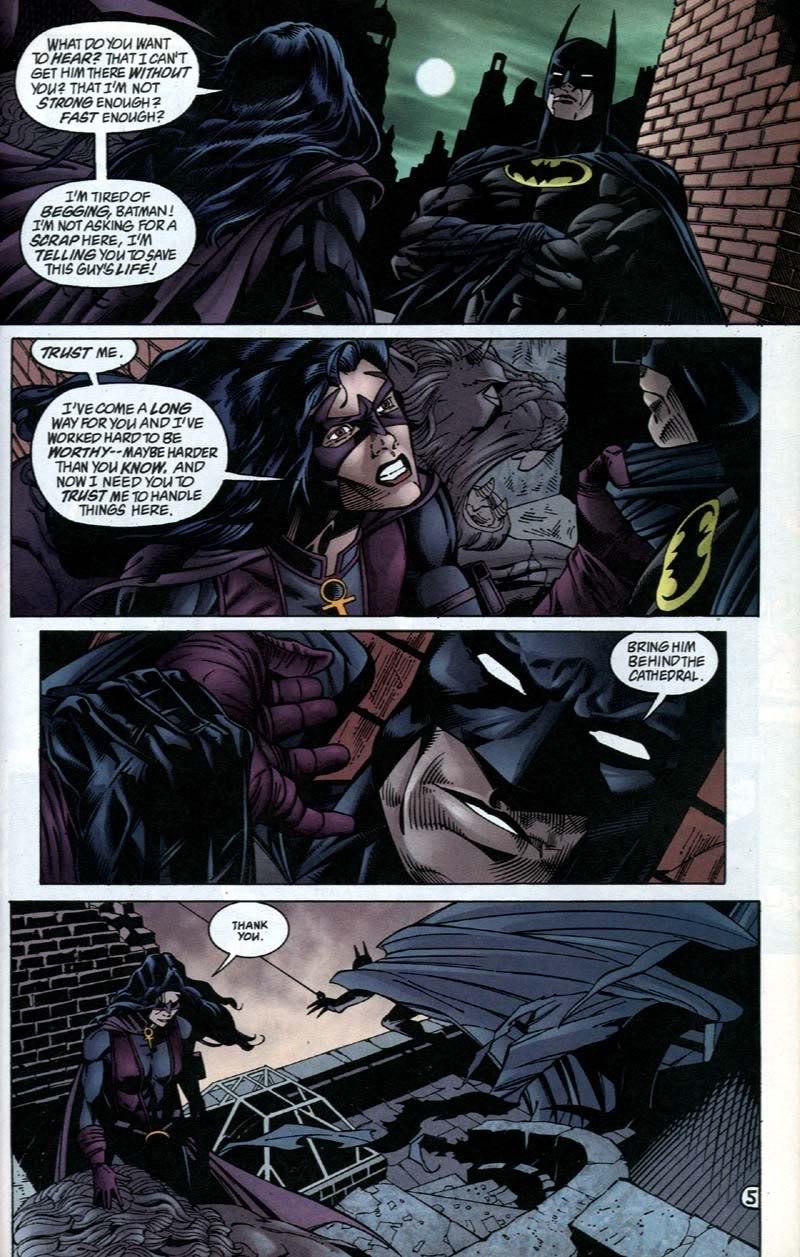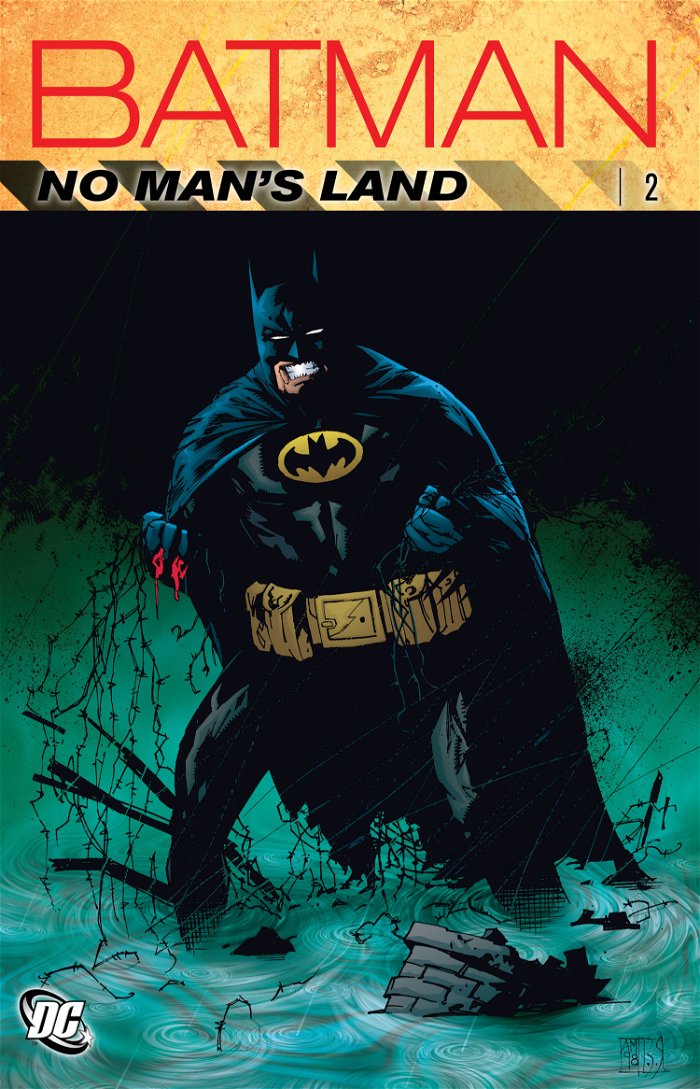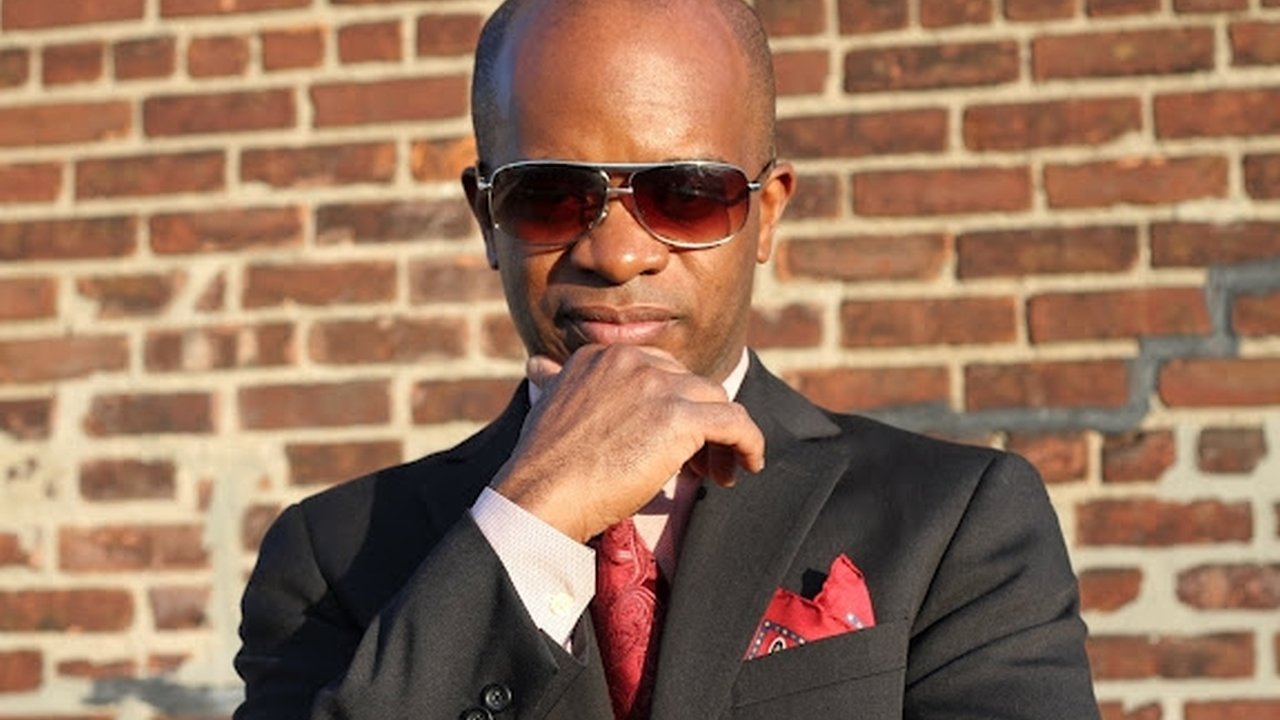A Conversation With Joe Illidge
This summer director Christopher Nolan ended his theatrical Batman saga with The Dark Knight Rises, a critically lauded film that ended his trilogy out on a very high note. For fans of the Batman comics, not only was the movie enjoyable, but it also took inspiration from some memorable storylines throughout the character’s storied history, including Frank Miller’s The Dark Knight Returns, Knightfall, which saw Bane break Batman’s back, and Batman: No Man’s Land, a year-long storyline that ran through the Batman family comics in 1999. One of the men working behind the scenes on No Man’s Land was Joe Illidge, Associate Editor at DC Comics at the time of its publication. We recently spoke to Joe about No Man’s Land and its legacy on both film and comics in the years since.
 C & G Magazine: When and how did you first start working at DC Comics?
C & G Magazine: When and how did you first start working at DC Comics?
Joe Illidge: Giving credit where it’s due, my career as a comic book editor began at Milestone Media, the first Black-owned mainstream comic book company and creators of the award-winning Warner Bros. cartoon Static Shock!. The late Dwayne McDuffie was my first editorial mentor. He taught me the craft of editing and how to work with creators to get the best results possible, meaning the best books on time from people who enjoy working with you.
After Milestone, I started working as an editorial freelancer in the Green Lantern office. At the time, Green Lantern was DC Comics’ third top-selling character in back of Batman and Superman.
When a position opened up in the Batman department, Batman Group Editor Dennis O’Neil and editor Jordan Gorfinkel offered me the job.
CGM: What were your responsibilities as an editor?
JI: That question comes with a lot of answers, because the best editors wear quite a few hats.
One part is being the ultimate coordinator and quality control expert, working with the writer, artist, letterer, and colorist to make sure all parties are doing their best to serve the story. Talking with your talent to make sure they’re on schedule and distributing a large volume of materials between different creators and different departments. It helps to have training in both writing and art, so you can speak to illustrators and authors in their language.
Another part is being a creative manager, because it’s your responsibility to make sure the books you work on help maintain and support the integrity of the intellectual property you’re handling. Being partially responsible for maintaining the world of Batman was exciting and full of potential landmines, but there’s lots of fun within the storm, like getting to pick new creators when your book is entering a new phase.
Finally, you provide support and counsel to your freelancers, who spend most of their day working at home, working on a script or a page of art.
So I did all of that, forty or more hours a week.
CGM: When did you start with the Batman editorial group? Which particular titles were you editing, and among which artists and writers were you working with?
After being traumatized by his failure to save Gotham, Batman mysteriously disappeared. His absence made it possible for the villains to take over the city. Forced to rediscover his purpose, Batman returned to Gotham to learn that the power of his myth no longer existed.JI: I started working with the Batman group in 1998, in the early stages of a highly ambitious and creative project, the one-year storyline called No Man’s Land. It was a 52-week, real-time saga in which Gotham City was cut off from the rest of the United States; the result of being deemed a hazard zone after suffering a viral epidemic and an earthquake. Without power, incoming currency or food, Gotham City was reduced to a feudal society where money was meaningless and gangs ruled the city through force.
After being traumatized by his failure to save Gotham, Batman mysteriously disappeared. His absence made it possible for the villains to take over the city. Forced to rediscover his purpose, Batman returned to Gotham to learn that the power of his myth no longer existed.
No Man’s Land went through the main four Batman titles, so I edited and co-edited issues of Batman, Legends of the Dark Knight, Detective Comics, and Shadow of the Bat. Additionally, I was the editor on Birds of Prey, DC Comics’ female-driven, high-action thriller buddy book, and consultant on the bible for the Birds of Prey television series.
CGM: What was the original planning behind No Man’s Land like? Was it loosely planned prior to Cataclysm, or did it come about after Cataclysm had already unfolded?
JI: I joined the Batgroup just as No Man’s Land started to get underway, so the earliest stages of planning had already happened. Exiting Bat-editor Jordan Gorfinkel took a weekend and crafted the 10-page document for what would eventually become Batman: No Man’s Land. It was the prototype bible that all of the Batman editors and various writers used to introduce new ideas and move the story forward.
One of the first things I did upon becoming a Batman editor was order the largest erasable marker board I could find. I created a huge crossover map which outlined the books in order of publication and the creators’ progress on each book.
In a sense, it was like being a showrunner on a television series, because that map worked with the No Man’s Land bible to help keep track of an entire year of Batman books. Since there were at least four monthly Batman titles, along with two special books and various other interrelated titles, we’re talking at least fifty Batman books.
After that, I was able to work with the creative teams and discuss stories with the bird’s eye view of a year in Batman’s world.
 CGM: Was NML always planned as a year-long event? Was it planned out in advance, or did it come up organically during the writing process?
CGM: Was NML always planned as a year-long event? Was it planned out in advance, or did it come up organically during the writing process?
JI: No Man’s Land was always planned as a year-long event. There were story and character beats for the entire year in the prototype bible, but as the editors and writers came together in creative summits, new ideas were generated.
CGM: Can you describe the process of developing the Gotham as seen in No Man’s Land, with regards to the rebuilding of the ruined Gotham as miniature tribal regions?
JI: The territories were partially based on the villains who ruled them like Two-Face, The Penguin, and eventually The Joker, but the most important character was Gotham City itself. Landmarks in Gotham became critical locations for territorial strongholds, like an industrial plant or the main police precinct.
When Batman began taking back Gotham City one territory at a time, he had to start using the rules of tribes and gangs, so he started tagging areas with the symbol of the bat.
Sound familiar?
CGM: Where did the idea come from to have the various factions fighting for what was left of Gotham, and showing the struggle between the tribes and their chieftains?
JI: The prototype bible laid that out, and the editors and writers worked together to flesh out the struggle. Tribal war was a natural result of Gotham’s society being reduced to a pre-technological age.
However, the most powerful people are not the strongest or most physically imposing. They’re the leaders, the people who have the greatest ability to inspire and persuade others. Because of that, certain villains were easily able to step up and claim power.
Two-Face set up a court system to try people he deemed criminal offenders in No Man’s Land Gotham. The Penguin became the ultimate trader for food, guns, clothes, and other resources. Meanwhile, Superman was totally impotent when he arrived in Gotham, because he couldn’t go against the government’s actions and his symbolism offered nothing to people scavenging for food and fighting to live another day.
 CGM: NML featured the introduction of first The Huntress as Batgirl, and later Cassandra Cain as Batgirl. What was the genesis for both of these characters?
CGM: NML featured the introduction of first The Huntress as Batgirl, and later Cassandra Cain as Batgirl. What was the genesis for both of these characters?
JI: Having the Huntress become Batgirl was an idea established in the prototype bible. It was perfect because Huntress understood the power of Batman’s symbol. Now, she had the chance to use it to re-establish justice without being judged or regulated by Batman…until he returned to Gotham.
Cassandra Cain as the new Batgirl came later, and was fleshed out through a team effort of the Batman editorial group, Cassandra Cain’s co-creator/writer Kelley Puckett, and co-creator/artist Damion Scott.
CGM: Was it always the plan to introduce a new Batgirl after Huntress’ time spent as Batgirl during the beginning of NML? What were the planning stages behind the evolution of the two Batgirls?
JI: Yep. The plan was always to have two people don the costume of the new Batgirl, with the successor being the person to ultimately adopt the identity. The unmasking of Huntress and Batman’s removal of the identity from her represented a shift point in the story.
With the second Batgirl, writer Kelley Puckett was instrumental in the co-creation of Batgirl as an Asian teenager with a mysterious past and a villainous father. Rumor at the time was that some of the powers-that-were at DC wanted another Caucasian redhead to don the costume. However, since No Man’s Land was a creatively courageous idea and storyline, the Batman group and its creators were gutsy enough to apply forward-thinking ideas. Batman Group Editor Dennis O’Neil backed our plays with the higher-ups.
Also, once the new Batgirl was established in her own series, then-Vertigo editors Jennifer Lee and Cliff Chiang (now superstar artist on Wonder Woman) sat down with me and Denny O’Neil to offer more ideas about Batgirl’s evolution and the avoidance of stereotypes.
CGM: No Man’s Land saw the introduction of Harley Quinn into Batman comics. What was the process of bringing the character into the comics like? When did the decision get made to bring Harley into the comics, let alone No Man’s Land?
Harley’s still a part of the DC Entertainment universe to this day, so the ripple effects of No Man’s Land continue to be seen.JI: It was more work and negotiation than usual, that’s for sure. Getting The Joker’s sidekick Harley Quinn from Batman: The Animated Series into the comics continuity involved working directly with parent company Warner Bros., the WB Animation group, and Harley’s co-creator Paul Dini.
Harley’s still a part of the DC Entertainment universe to this day, so the ripple effects of No Man’s Land continue to be seen.
CGM: NML ended with the particularly dramatic death of Sarah Essen-Gordon, Commissioner Gordon’s wife. What was the mood in editorial when it came to killing off Gordon’s wife—as his daughter Barbara/Batgirl/Oracle had already been crippled by the Joker in The Killing Joke?
JI: It’s the kind of thing that gives you a bad feeling in a good way because it’s dramatic and powerful. The idea came up during a phone conference between the Batman editorial group and one of the main No Man’s Land writers. When it was thrown out for discussion, we all knew it was the right way to go.
The death of Sarah Essen-Gordon showed the ultimate consequence of No Man’s Land. To have Batman and his entire city go through a year of hell and come out of it with no loss of life on the heroes’ side would be ridiculous. More importantly, the loss struck at the other part of Gotham’s soul, Commissioner James Gordon, the man who stayed behind when Batman disappeared.
CGM: Do you have any regrets about certain facets of NML? Any subplots or stories that were cut, or that should have been?
JI: I feel like No Man’s Land gave all of the characters and main storylines their time. In addition to Batman and the costumed heroes, we were able to profile the cops. I hired award-winning novelist Steven Barnes to write a story about Mackenzie “Hardback” Bock, a Black police detective who fought to maintain order in his two-hundred block territory. Latina officer Renee Montoya became a more integral character in No Man’s Land as the story evolved.
My only regret is that in planning the Batman line-wide relaunch after No Man’s Land, I wasn’t able to get my hands on the Catwoman book. I wanted to take Catwoman and turn it into a 21st century cinematic thief comic. I was ready to contact Dan Curtis Johnson and J.H. Williams (now Batwoman illustrator), because they were the team from Chase, which was such a great comic. Looking at how Anne Hathaway portrayed Catwoman in The Dark Knight Rises, I was thinking about how I envisioned a similar feel for the comic book years before.
CGM: Was working on such an intensive and extensive storyline for a year an engaging experience, or was it more tiring?
JI: Working as a Batman editor during No Man’s Land was engaging and absolutely immersive, and a great test for my skills as an editor, story consultant, and project manager.
There are various writers and artists I met during No Man’s Land that I still have great relationships with to this day. That also extends to Dennis O’Neil, my second editorial mentor, and editors Jordan Gorfinkel, Darren Vincenzo, and Frank Berrios.
I love the new collected trade paperbacks of Batman: No Man’s Land that DC Entertainment has released throughout the year. The work we all put into it, editors, creators, production staff, designers, and so on…it still holds up.
CGM: What were your favorite moments in NML, both those you were and weren’t involved with?
JI: It’s hard for me to pick any favorites because I loved the entire experience and Batman: No Man’s Land is a whole greater than the sum of its parts. That said, working on Batman: No Man’s Land #0 with writers Jordan Gorfinkel and Greg Rucka and the art team was great, because fans would finally see what happened to Bruce Wayne during his time away from Gotham.
Working with editor Eddie Berganza on the Young Justice: No Man’s Land book was also a highlight. Eddie and I had a great working relationship, and dealing with Robin and the teenage DC heroes breaking into No Man’s Land was an idea worth exploring. Seeing Young Justice now as a show on Cartoon Network speaks to how interesting those characters are, so I was happy to have a chance to be an editorial consultant on that comic.
CGM: What were your thoughts on Dark Knight Rises, which has a clear influence from NML?
JI: I think it’s fair to say we were ahead of the curve.
I was surprised by the similarities, but it made perfect sense. The Nolan Batman mythology is clearly influenced by the more seminal storylines of the Batman comic books Batman: Year One, Knightfall, and No Man’s Land.
Christian Bale has publicly acknowledged and praised Batman graphic novels as exemplary source material, and there has not been another Batman storyline quite like No Man’s Land since. One year, real time, no gimmicks or quick resolutions, no single villain responsible, no getting saved by Superman and the Justice League of America, no time travel or retroactive continuity, and someone important to the cast died.
CGM: Which elements of NML do you think that DKR improved on, and which you do you think NML was superior in?
JI: That’s tough.
No Man’s Land had the space to show the full scope of cause and effect with the city and its characters, while The Dark Knight Rises only had a few hours. Also, No Man’s Land had a chronicler of events in the character of Barbara Gordon as Oracle,I’d say the idea of having Catwoman in Gotham during the city’s descent, showing her dispensing street justice out of costume as Selina Kyle is something The Dark Knight Rises had which I would have loved to see in No Man’s Land. Selina Kyle is street all the way, so that kind of scenario is perfect for digging into her character and showing her full set of urban survival skills.
On the other end, No Man’s Land had the space to show the full scope of cause and effect with the city and its characters, while The Dark Knight Rises only had a few hours. Also, No Man’s Land had a chronicler of events in the character of Barbara Gordon as Oracle, whereas The Dark Knight Rises had no one charting the—supposed—last days of Gotham City with a nuclear end on the horizon.
CGM: As it’s been over a decade since NML unfolded, where has your own career taken you in the intervening years?
JI: After my time at DC Comics, I founded a production company called Verge Entertainment with Shawn Martinbrough, the illustrator on Robert Kirkman’s successful Thief of Thieves for Image Comics, and Milo Stone, who’s worked for major video game companies and digital technology clients. We’ve shot award-winning films, produced the promotional trailer for the Howard Theater Restoration Project in Washington, D.C., and worked on projects for corporate clients. Verge has a number of intellectual properties for use in the entertainment industry, covering live-action, animation, prose, children’s books, and graphic novels.
I became the Comics Editor at Archaia, where I worked for President Aki Liao and Publisher Mark Smylie. They were the best bosses, devoted to creating unique graphic novels within a collaborative company environment. After working on probably the most profitable corporate-owned character in superhero comics, it was a refreshing and necessary change of pace to work for an independent company publishing creator-owned projects.
What I’m really jazzed about right now is The Ren, a 200-page graphic novel I’m co-writing for First Second Books/Macmillan. In 1920’s Harlem, New York, two Black teenage artists fall in love and pursue their dreams of fame in The Haven, a secret nightclub for Black writers, artists, and musicians. Run by former crime boss Lawrence Denton, The Haven becomes a battleground when a mysterious crime cartel starts a war to take the nightclub by force.
Shawn Martinbrough is the co-writer/co-creator and the illustrator / co-creator is Grey Williamson. Grey has worked on Batman for DC Comics in addition to various projects for Valiant, and his artwork is stunning.
This is a great time for creators and creator-owned work, so I’m excited about writing, editing, and developing new books and multimedia projects to help expand the entertainment landscape.



